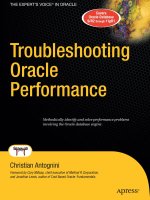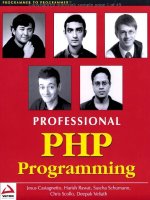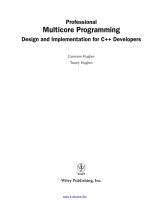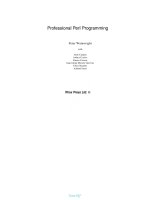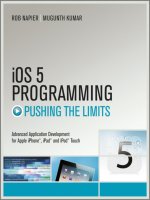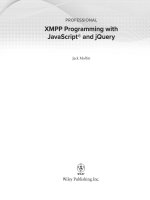Wiley Professional Oracle Programming Jun 2005-0764574825
Bạn đang xem bản rút gọn của tài liệu. Xem và tải ngay bản đầy đủ của tài liệu tại đây (23.8 MB, 793 trang )
Professional Oracle® Programming
Rick Greenwald, Robert Stackowiak, Gary Dodge, David Klein, Ben Shapiro,
Christopher G. Chelliah
01_574825 ffirs.qxd 5/13/05 12:52 PM Page iii
01_574825 ffirs.qxd 5/13/05 12:52 PM Page ii
Professional Oracle® Programming
01_574825 ffirs.qxd 5/13/05 12:52 PM Page i
01_574825 ffirs.qxd 5/13/05 12:52 PM Page ii
Professional Oracle® Programming
Rick Greenwald, Robert Stackowiak, Gary Dodge, David Klein, Ben Shapiro,
Christopher G. Chelliah
01_574825 ffirs.qxd 5/13/05 12:52 PM Page iii
Copyright © 2005 by Wiley Publishing Inc. All rights reserved.
Published by Wiley Publishing, Inc., Indianapolis, Indiana
Published simultaneously in Canada
No part of this publication may be reproduced, stored in a retrieval system, or transmitted in any form or by
any means, electronic, mechanical, photocopying, recording, scanning, or otherwise, except as permitted
under Section 107 or 108 of the 1976 United States Copyright Act, without either the prior written permis-
sion of the Publisher, or authorization through payment of the appropriate per-copy fee to the Copyright
Clearance Center, Inc., 222 Rosewood Drive, Danvers, MA 01923, (978) 750-8400, fax (978) 646-8700. Requests
to the Publisher for permission should be addressed to the Legal Department, Wiley Publishing, Inc., 10475
Crosspoint Blvd., Indianapolis, IN 46256, (317) 572-3447, fax (317) 572-4355, or online at
http://www.
wiley.com/go/permissions
.
LIMIT OF LIABILITY/DISCLAIMER OF WARRANTY: THE PUBLISHER AND THE AUTHOR MAKE
NO REPRESENTATIONS OR WARRANTIES WITH RESPECT TO THE ACCURACY OR COMPLETENESS
OF THE CONTENTS OF THIS WORK AND SPECIFICALLY DISCLAIM ALL WARRANTIES, INCLUDING
WITHOUT LIMITATION WARRANTIES OF FITNESS FOR A PARTICULAR PURPOSE. NO WARRANTY
MAY BE CREATED OR EXTENDED BY SALES OR PROMOTIONAL MATERIALS. THE ADVICE AND
STRATEGIES CONTAINED HEREIN MAY NOT BE SUITABLE FOR EVERY SITUATION. THIS WORK IS
SOLD WITH THE UNDERSTANDING THAT THE PUBLISHER IS NOT ENGAGED IN RENDERING
LEGAL, ACCOUNTING, OR OTHER PROFESSIONAL SERVICES. IF PROFESSIONAL ASSISTANCE IS
REQUIRED, THE SERVICES OF A COMPETENT PROFESSIONAL PERSON SHOULD BE SOUGHT.
NEITHER THE PUBLISHER NOT THE AUTHOR SHALL BE LIABLE FOR DAMAGES ARISING HERE-
FROM. THE FACT THAT AN ORGANIZATION OR WEBSITE IS REFERRED TO IN THIS WORK AS A
CITATION AND/OR A POTENTIAL SOURCE OF FURTHER INFORMATION DOES NOT MEAN THAT
THE AUTHOR OR THE PUBLISHER ENDORSES THE INFORMATION THE ORGANIZATION OR
WEBSITE MAY PROVIDE OR RECOMMENDATIONS IT MAY MAKE. FURTHER, READERS SHOULD BE
AWARE THAT INTERNET WEBSITES LISTED IN THIS WORK MAY HAVE CHANGED OR DISAP-
PEARED BETWEEN WHEN THIS WORK WAS WRITTEN AND WHEN IT IS READ.
For general information on our other products and services please contact our Customer Care Department
within the United States at (800) 762-2974, outside the United States at (317) 572-3993 or fax (317) 572-4002.
Trademarks: Wiley, the Wiley Publishing logo, Wrox, the Wrox logo, and Programmer to Programmer are
trademarks or registered trademarks of John Wiley & Sons, Inc. and/or its affiliates. All other trademarks
are the property of their respective owners. Wiley Publishing, Inc., is not associated with any product or
vendor mentioned in this book.
Wiley also publishes its books in a variety of electronic formats. Some content that appears in print may not
be available in electronic books.
Library of Congress Cataloging-in-Publication Data:
Professional Oracle programming / Rick Greenwald ... [et al.].
p. cm.
Includes indexes.
ISBN-13: 978-0-7645-7482-5 (paper/website)
ISBN-10: 0-7645-7482-5 (paper/website)
1. Oracle (Computer file) 2. Relational databases. I. Greenwald, Rick.
QA76.9.D3P76646 2005
005.75'85--dc22
2005010511
ISBN 13: 978-076-457482-5
ISBN 10: 0-7645-7482-5
Printed in the United States of America
10 9 8 7 6 5 4 3 2 1
1B/QS/QW/QV/IN
01_574825 ffirs.qxd 5/13/05 12:52 PM Page iv
About the Authors
Rick Greenwald has been in the technology industry for over 20 years and is the author of 12 previous
books, most of them on Oracle. He has been involved with development and databases for his entire
career, including stops at Data General, Cognos, Gupta Technologies, and his current employer, Oracle.
Computers and computing are a sideline for Rick — his real job is father to his three wonderful girls,
with a primary hobby of music appreciation.
Robert Stackowiak is Senior Director of Business Intelligence (BI) in Oracle’s Technology Business Unit.
He is recognized worldwide for his expertise in business intelligence and data warehousing in leading
the North American BI team at Oracle. His background includes over 20 years in IT related roles at
Oracle, IBM, Harris Computer Systems, and the U.S. Army Corps of Engineers including management
of technical teams, software development, sales and sales consulting, systems engineering, and business
development.
Gary Dodge has been focused on database technology since his first COBOL programming job with IMS
DB/DC in 1976. He joined Oracle Corporation in 1987 and has served in various management and
technical positions within both the sales and consulting divisions. He has been a frequent speaker on
database topics at many local and national information technology conferences. In addition to several
magazine articles, he is co-author (with Tim Gorman) of Oracle8 Data Warehousing and Essential Oracle8i
Data Warehousing, both published by John Wiley & Sons.
David Klein has been in the technology industry for over 20 years with a variety of companies, including
Data General, Wang Laboratories, Gupta Technologies, Oracle, and a few consulting services companies.
He has had many roles, including management of application development and database design teams,
sales and sales consulting, systems engineering and marketing. Recently, he has focused on developing
classroom and online training courses. An active wife and two boys and a 200-year-old house take up any
free time.
Ben Shapiro is the president of ObjectArts Inc., a New York City-based technology consulting company,
and has been designing database systems with Oracle since 1997. ObjectArts has worked with many
large corporate clients developing XML-based publishing tools and web-based applications. Before
ObjectArts, Ben worked with several NYC-based startup companies as a technical lead building content
management software.
Christopher G. Chelliah joined Oracle as a Consultant in 1995. He brings with him project management,
architecture, and development experience from a number of large, multinational sites in the mining, oil
and gas, and telecom industries. Chris has been involved with emerging and database technologies for
his entire career and is an accomplished software architect with a flair for business development. His
expertise has been actively sought by a number of major Oracle clients in Australia, Europe, and the
United States. Chris, his wife and two kids are currently in Singapore, where he leads a team defining
and executing on innovative E-Government strategies for Oracle’s Public Sector industry in Asia Pacific.
01_574825 ffirs.qxd 5/13/05 12:52 PM Page v
01_574825 ffirs.qxd 5/13/05 12:52 PM Page vi
Credits
Vice President and Executive Group Publisher
Richard Swadley
Vice President and Publisher
Joseph B. Wikert
Executive Editor
Robert Elliott
Editorial Manager
Mary Beth Wakefield
Senior Production Editor
Geraldine Fahey
Development Editor
Sharon Nash
Production Editor
Felicia Robinson
Technical Editors
Michael Ault, Tim Gorman,
Wiley-Dreamtech India Pvt Ltd
Text Design & Composition
Wiley Composition Services
01_574825 ffirs.qxd 5/13/05 12:52 PM Page vii
01_574825 ffirs.qxd 5/13/05 12:52 PM Page viii
Acknowledgments
Although there are a number of names listed on the title page of this book, there are many other people
involved in the creation of the work you are currently reading.
First and foremost, all of the authors would like to thank Bob Elliott and Sharon Nash for their steady
hands on the throttle of this project. Although the birthing of this baby had more than the normal share
of labor pains, the worth and beauty of this offspring owes an enormous amount to them.
Rick Greenwald, in particular, would like to thank two people. First of all, the process of writing three
(is it three already) titles and several revisions of books with Bob Stackowiak has been a wonderful
experience, both professionally and personally. I am delighted to count Bob as a friend, and, thanks to
him, I still don’t know what BI stands for.
Secondly, throughout my writing career, Steven Feurstein has been a mentor as well as a sterling example
of what an author and person should be like. I hope to someday reach his level in terms of writing and,
even more importantly, humanity.
And, of course, I would like to thank my family — LuAnn for helping me have a life that supports writing
and working, and Elinor Vera, Josephine, and Robin Greenwald for giving me all the inspiration anyone
would ever need.
In addition, Rick would like to acknowledge all those people who came through with suggestions and
knowledge at crucial times, including Richard Foote, Raj Mattamal and Tyler Muth.
01_574825 ffirs.qxd 5/13/05 12:52 PM Page ix
01_574825 ffirs.qxd 5/13/05 12:52 PM Page x
Contents
About the Authors v
Acknowledgments ix
Introduction xxvii
Introduction xxvii
What Does This Book Cover? xxvii
Who Is This Book For? xxvii
What You Need to Use This Book xxviii
How Is This Book Structured? xxviii
Part I: Oracle Essentials xxviii
Part II: Data Topics xxix
Part III: Database Programming Languages xxix
Part IV: Programming Techniques xxix
Part V: Business Intelligence Techniques xxx
Part VI: Optimization xxx
The Bigger Picture xxx
Conventions xxx
Source Code xxxi
Errata xxxi
p2p.wrox.com xxxii
Chapter 1: Oracle Architecture and Storage 1
Architecture 2
The Instance 2
Data Organization 6
Data Types 9
Character Data Types 9
BFILE 10
Numeric Data Types 11
Date Data Types 12
RAW and LONG RAW 12
Other Data Types 13
Summary 13
02_574825 ftoc.qxd 5/13/05 12:52 PM Page xi
xii
Contents
Chapter 2: Using SQL 15
The Processing Cycle for SQL Statements 15
Connecting to a Database 16
Establishing a Cursor 18
Submitting SQL Statements 18
Receiving Data 21
Performance Considerations 21
Retrieval Performance 22
Using Bind Variables 23
Parallel Operations 25
Summary 26
Chapter 3: Handling Multiple Users 27
Goals 28
Data Integrity 28
Isolation 29
Serialization 29
Transactions 29
Concurrent User Integrity Problems 30
Locks 33
Contention 34
The Oracle Solution 35
Multiversion Read Consistency 35
Integrity Implications 37
Performance Implications 37
Isolation Levels 38
Implementation Issues 39
Write Contention 39
Avoiding Changed Data 40
Summary 41
Chapter 4: Database Design Basics 43
Database Design Phases 45
Conceptual Database Design 45
Logical Database Design 45
Physical Design 46
Practical Design 47
Database Design Tools 48
Database Design Techniques 49
Database Design Case Study Example 53
02_574825 ftoc.qxd 5/13/05 12:52 PM Page xii
xiii
Contents
Normalization 54
First Normal Form 56
Second Normal Form 59
Third Normal Form 60
Other Keys 60
Normalization Summary 62
Defining Additional Entities (Tables) 62
Denormalization 63
Other Physical Design Options 64
Object-Oriented Design Options of Oracle 66
Summary 66
Chapter 5: Oracle Security 67
Security Concepts 67
Confidentiality and Privacy 67
Integrity 68
Why Database-Level Security? 68
Authentication 69
Users and Passwords 69
Smart Cards and Biometric Identification 70
Oracle Syntax 70
Authorization 73
System Privileges 74
Object Privileges 74
Roles 75
Stored Procedures 78
Access Control 78
Views 79
Encryption 80
Virtual Private Database 81
Oracle Label Security Option 84
Accountability 85
Auditing 85
Triggers 88
Enterprise Security 88
LDAP 89
Enterprise Users 89
Shared Schemas 89
Database Security 90
Network Security 90
Security Practices 92
Summary 92
02_574825 ftoc.qxd 5/13/05 12:52 PM Page xiii
xiv
Contents
Chapter 6: The Oracle Data Dictionary 93
What Is the Data Dictionary? 93
Structure of the Oracle Data Dictionary 94
USER_TABLES 95
ALL_TABLES 96
DBA_TABLES 97
TAB 98
V_$FIXED_TABLE 99
The Oracle Data Dictionary During Development 101
Locating and Describing Data Dictionary Views 101
Which Set of Views? 103
Updating the Data Dictionary 107
The Oracle Data Dictionary at Execution Time 108
SQL to Generate SQL 108
Dynamic SQL 110
Summary 112
Chapter 7: Installing Oracle 113
Getting Oracle Software 113
Installing Oracle Server Software 116
System Requirements 116
Installing the Software 117
Accessing Your Oracle Database 122
Installing Oracle Client Software 123
Java Drivers 124
Oracle Client Software 124
Installing the Instant Client 125
Which Driver? 126
Summary 127
Chapter 8: Introduction to SQL 129
A Bit of History 129
Standards 130
SQL Statement Groupings 130
Data Definition Language (DDL) 131
CREATE 131
ALTER 133
DROP 134
Caveat! 134
Data Manipulation Language (DML) 135
02_574825 ftoc.qxd 5/13/05 12:52 PM Page xiv
xv
Contents
SQL: Set-Orientated and Nonprocedural 135
SELECT Statement 135
Multi-Table Access 147
Subqueries 150
Insert 153
UPDATE 155
DELETE 155
COMMIT/ROLLBACK/SAVEPOINT 156
Summary 156
Chapter 9: Extended SQL 159
Extended Conditions 159
LIKE and REGEXP_LIKE 159
IN and EXISTS 160
ALL, SOME, and ANY 164
Extended Set Operations 166
UNION 166
INTERSECT 168
MINUS 169
MERGE 171
An Example 172
Caveats 173
TRUNCATE 174
ROWNUM and Ranking 174
Using ROWNUM 174
Using Analytics 177
Flashback Query 179
How It Works 180
Syntax 180
An Example of Flashback Query 180
Caveats 183
Extended Flashback Capabilities 183
Returning Data from Write Operations 183
Additional Extensions 184
Summary 184
Chapter 10: Indexes 185
Index Basics 186
How an Index Works 186
Keys 190
Index Attributes 190
02_574825 ftoc.qxd 5/13/05 12:52 PM Page xv
xvi
Contents
B-Tree Indexes 193
How It Works 193
B-Tree Index Myths 194
Reverse Key Indexes 196
Function-Based Indexes 197
Function-Based Indexes at Work 198
Caveats 201
Domain Indexes 202
Bitmap Indexes 202
The Structure of a Bitmap Index 203
The Impact of a Bitmap Index 204
Bitmap Join Index 206
Index-Organized Tables 207
Index Clusters 207
Hash Cluster 209
Design and Performance Tips 209
Start Small 209
Key Compression 210
SQL Access Advisor 211
Summary 211
Chapter 11: Constraints 213
Database Integrity Features 213
Data Typing 214
Constraints 215
Triggers and Stored Procedures 215
Types of Constraints 216
NOT NULL 217
PRIMARY KEY 219
UNIQUE 221
FOREIGN KEY 222
CHECK 226
DEFAULT 230
REF Constraints 231
Working with Constraints 232
Alter Table 233
Constraint States 234
Constraints and Indexes 236
Deferrable Constraints 238
Direct Path Operations 238
Constraints and Export/Import 239
Effect on Mutating Table Triggers 239
02_574825 ftoc.qxd 5/13/05 12:52 PM Page xvi
xvii
Contents
Constraints on Views 239
Using Database Constraints for Application-Side Rule Checking 240
Summary 240
Chapter 12: Other Database Structures 241
Tablespaces 241
Temporary Tablespaces 242
Undo Tablespaces 243
Compression 243
Partitioning 245
Views 246
Materialized Views 248
Sequences 248
Global Temporary Tables 250
Recycle Bin 250
Synonyms 253
Why Use Synonyms? 253
Working with Synonyms 253
Database Links 255
Advanced Queuing and Streams 255
Streams AQ 255
Streams 256
Streams Summary 258
Objects 258
Stored Procedures, Functions, and Triggers 259
Accessing Flat Files 260
External Tables 260
UTL_FILE 260
SGA Buffer Pool Assignments 260
Workflows 261
Workspace Manager 262
Summary 263
Chapter 13: Functions 265
What Is a Function? 265
Defining Your Own Functions 265
Permissions to Create Functions 266
Where Can Functions Be Used? 266
Defining a Java Function 267
Viewing Information about Your Functions 267
Deleting a Function 268
02_574825 ftoc.qxd 5/13/05 12:52 PM Page xvii
xviii
Contents
Oracle’s Built-In SQL Functions 268
Aggregate Functions 268
Numeric Functions 275
Character Functions 281
Date and Time Functions 288
Conversion Functions 295
Collection Functions 303
Other Oracle Functions 303
XML Functions 309
Summary 313
Chapter 14: Distributed Queries, Transactions, and Databases 315
Linking Distributed Oracle Databases 316
Distributed Transactions and Two-Phase Commit 319
Heterogeneous Services 320
ODBC 321
Transparent Gateways 322
Summary 323
Chapter 15: PL/SQL Basics 325
Code Architecture 325
The Block Header 326
The Declaration Section 328
The Execution Section 328
The Exception Section 329
How Exceptions Are Handled 329
Error-Related Functions 330
Scoping and Notation 330
PL/SQL language 331
Implementing Logic 335
Conditional Logic 335
Branching 338
Iterative 339
Doing Nothing 340
Creating a PL/SQL Program 341
The Purpose of the Sample Procedure 341
Starting the Code 341
Adding Variables 342
Adding Logic 342
Adding Exception Handling 343
02_574825 ftoc.qxd 5/13/05 12:52 PM Page xviii
xix
Contents
Using PL/SQL Code 344
Preparing for Compilation 344
Compiling PL/SQL Code 344
Running PL/SQL Code 345
Compilation, Source Code, and Dependencies 346
Security 348
Granting Access to PL/SQL units 348
Program Unit Rights 348
Native Compilation 349
Uses of PL/SQL Units 350
Summary 350
Chapter 16: PL/SQL and SQL 351
Basic SQL in PL/SQL 351
Cursors 352
Creating a Cursor 352
Opening a Cursor 352
Fetching Data 352
Closing the Cursor 353
Cursor Attributes 353
Using a Single Cursor 353
Declare Variables 354
Declare Cursor 354
Open a Cursor 354
Fetch 355
Clean Up 356
Running the Procedure 356
Special Data Types 357
%TYPE 357
%ROWTYPE 358
FOR Cursor 359
Syntax 359
Modifying the Example 359
Implicit Cursors 360
REF CURSORs 362
PL/SQL Records and Collections 363
PL/SQL Records 363
PL/SQL Records and SQL 364
Associative Arrays 364
Nested Tables 365
Variable Arrays 366
02_574825 ftoc.qxd 5/13/05 12:52 PM Page xix
xx
Contents
Working with Collections 366
Collection Operations 367
Which Collection Type? 369
BULK COLLECT 369
Using BULK COLLECT 370
FORALL 373
Exception Cases 373
FORALL Enhancements 374
Dynamic SQL 375
EXECUTE IMMEDIATE 376
Bulk Operations with Dynamic SQL 376
More on Dynamic SQL 376
Summary 376
Chapter 17: PL/SQL Packages 379
What Is a Package? 379
Impact of Packages 380
Organization 381
Visibility 381
Scope 381
Dependencies 382
Runtime Memory Usage 382
Oracle’s Endorsement 383
An Example 383
The Package Specification 383
The Package Body 384
Running the Example 390
Using Packages Together 391
Your Second Package 392
Package Code 392
Changing the First Package 393
Impact on the Second Package 394
Summary 396
Chapter 18: Introduction to Java Database Programming 397
Java Architecture 398
Java: The Language 398
Java Virtual Machine and Bytecode 398
What about Performance? 399
J2SE and J2EE 400
Oracle’s Java Architecture 406
JDBC and Persistence Frameworks 408
02_574825 ftoc.qxd 5/13/05 12:52 PM Page xx
xxi
Contents
Java outside the Database 411
Java inside the Database 412
Building Sample Applications 413
Setting the CLASSPATH 413
Java Application Using JDBC — Basic Ingredients 414
Java Application Using OracleAS TopLink 419
Java Stored Procedures 427
Summary 434
Chapter 19: Triggers 437
What Are Triggers? 437
Types of Triggers 437
Order of Execution 438
Working with Triggers 438
Naming Triggers 438
Permissions for Creating Triggers 439
Creating Triggers 439
:new and :old 440
Update Triggers 441
Delete Triggers 441
Controlling When the Trigger Fires 442
Inserting or Updating? 443
Special Circumstances 443
INSTEAD OF Triggers 444
Triggers for Referential Integrity 448
Triggers in Other Languages 448
Triggers and Mutating Tables 449
Removing Triggers 451
Deleting/Dropping Triggers 451
Disabling Triggers 451
Recompiling Triggers 452
Viewing Triggers in the Data Dictionary 452
Limitations of Triggers 453
Summary 453
Chapter 20: Regular Expressions and Expression Filter 455
Regular Expressions 456
Regular Expression Concepts 457
Relevance to Database Applications 461
Oracle Regular Expressions 462
Usage Scenarios 470
02_574825 ftoc.qxd 5/13/05 12:52 PM Page xxi
xxii
Contents
Architecture and Performance Considerations 475
Expression Filter 476
Expression Filter Concepts 478
Relevance to Database Applications 484
Summary 485
Chapter 21: Object Relational Interactions with Oracle 487
Object Relational 488
ODBMS and RDBMS and ORDBMS 488
Introducing Oracle Objects 489
Object Types 490
Object Type Methods 493
Inheritance Support 497
Schema Evolution 499
Mapping to UML Concepts 500
Using Oracle Object Types 501
Existing Java Class as a Persistent Object Type 501
Creating Instances of Object Types in the Database 504
Using Java to Interact with Database Objects 506
Object Views on Relational Data 511
Oracle JPublisher (JPub) 515
Configuration and Run Time 516
Publishing SQL and DML Statements 517
Publishing Java Stored Procedures 518
Publishing Object Types 519
Support for Web Services 520
Summary 520
Chapter 22: Oracle XML DB 521
Overview of the XML DB Repository 521
Protocol-Based Access to XML in the Oracle Repository 522
SQL-Based Access to XML Data in the Oracle Repository 529
Enabling a New Schema for Use with XDB Repositories 533
ACL-Based Security on Oracle XML Repositories 533
XMLType 536
Creating XMLType Columns and Tables 537
XML Views 538
XML Schema 540
SQL/XML and Query Rewrite 533
SQL to XML 554
02_574825 ftoc.qxd 5/13/05 12:52 PM Page xxii

